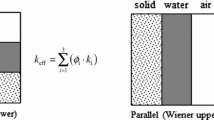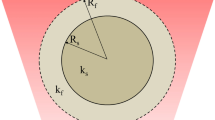Abstract
Effective thermal conductivity measurements on unsaturated soils by means of the probe method (thermal conductivity probe, TCP) often present a nonlinear trend of \(\Delta T\) versus ln (\(\tau \)). Three different slopes are present in the plots, while a homogeneous material should present only one. Being soils composite structures made of different phases (solid earth, liquid water and air), a possible explanation is the presence of phenomena other than pure conduction, such as water evaporation and vapor migration through the soil structure. A numerical model based on finite differences has been developed to simulate these phenomena. The model takes into account several factors including heat conduction, heat storage due to thermal capacity, water evaporation and water diffusion through a porous medium. Results show that two of the three slopes can be successfully simulated by the model, confirming the interpretation of the phenomena. However, the third slope from the experimental data is lower than the model’s slope, likely indicating the presence of other phenomena not yet taken into account, such as capillarity.









Similar content being viewed by others
Abbreviations
- a :
-
Extent of reaction
- A :
-
Fick equation area [\(\hbox {m}^{2}\)]
- \(c_\mathrm{p}\) :
-
Specific heat [\(\hbox {J}\cdot \hbox {kg}^{-1}\cdot \hbox {K}^{-1}\)]
- C :
-
Concentration [\(\hbox {kg}\cdot \hbox {m}^{-3}\)]
- Fo:
-
Fourier number
- I :
-
Electric current [A]
- K :
-
Mass transfer coefficient [\(\hbox {kg}\cdot \hbox {m}^{-2}\cdot \hbox {s}^{-1}\)]
- L :
-
Probe length [m]
- m :
-
Mass [kg]
- \({\dot{m}}\) :
-
Mass flow rate [\(\hbox {kg}\cdot \hbox {s}^{-1}\)]
- \(\dddot{q}\) :
-
Specific thermal power generated or absorbed [\(\hbox {W}\cdot \hbox {m}^{-3}\)]
- \({\dot{Q}}\) :
-
Thermal power [W]
- r :
-
Radius [m]
- R :
-
Heater wire resistance [\(\Omega \)]
- \(\Delta R^{*}\) :
-
Dimensionless grid size
- s :
-
Thickness [m]
- S :
-
External surface of the probe [\(\hbox {m}^{2}\)]
- \(\hbox {S}^{{*}}\) :
-
Free water surface [\(\hbox {m}^{2}\)]
- T :
-
Temperature [\({^{\circ }}\hbox {C}\)]
- x :
-
Volume fraction
- \(W_\mathrm{ser}\) :
-
Weight of the series component
- \(\alpha \) :
-
Thermal diffusivity [\(\hbox {m}^{2}\cdot \hbox {s}^{-1}\)]
- \(\delta \) :
-
Stability criteria
- \(\lambda \) :
-
Thermal conductivity [\(\hbox {W}\cdot \hbox {m}^{-1}\cdot \hbox {K}^{-1}\)]
- \(\rho \) :
-
Density [\(\hbox {kg}\cdot \hbox {m}^{-3}\)]
- \(\tau \) :
-
Time [s]
- \(\Delta \tau \) :
-
Time step [s]
- \(\varphi \) :
-
Relative humidity
- \(\chi \) :
-
Humidity ratio [\(\hbox {kg}_{\mathrm {water}} \cdot \hbox {kg}_{\mathrm {dryair}}^{\mathrm {-1}} \)]
- \(\psi \) :
-
Degree of saturation
- eq :
-
Equivalent
- f :
-
Final condition
- gas :
-
Gas phase
- liq :
-
Liquid phase
- p :
-
Relative to probe surface
- par :
-
Parallel
- pr :
-
Probe
- sam :
-
Relative to sample edge
- ser :
-
Series
- sol :
-
Solid phase
- vap :
-
Vapor
- 0 :
-
Initial condition
- pr:
-
Probe
- FD:
-
Finite differences
- TCP:
-
Thermal conductivity probe
- TGA:
-
Thermo-gravimetric analysis
References
V.R. Tarnawski, W.H. Leong, B. Wagner, F. Gori, An expert system for estimating soil thermal and transport properties, in Proceedings on ASME—ZSITS International Thermal Science Seminar, pp. 151–156, (2000). doi:10.1615/ICHMT.2000.TherSieProcVol2TherSieProcVol1.200
A.E. Wechsler, in The Probe Method for Measurement of Thermal Conductivity, ed. by K.D. Maglić, A. Cezairliyan, V.E. Peletsky. Compendium of Thermophysical Property Measurement Methods (Springer, US, 1992), pp. 161–185. doi:10.1007/978-1-4615-3286-6_6
P. Coppa, G. Pasquali, Thermal conductivity of lipidic emulsions and its use for production and quality control, in 2nd International Symposium on Instrumentation Science and Technology, Jinan, 18–22 Aug (2002)
G. Bovesecchi, P. Coppa, Basic problems in thermal-conductivity measurements of soils, Int. J. Thermophys. 34(10), 1962–1974 (2013). doi:10.1007/s10765-013-1503-2
S. Corasaniti, G. Pasquali, P. Coppa, Thermal conductivity of Ottawa sand partially and totally saturated with water, in X Convegno Nazionale AIPT, Torino, pp. 45–56 (2004)
V.R. Tarnawsky, D.J. Cleland, S. Corasaniti, F. Gori, R.H. Mascheroni, Extension of soil thermal conductivity models to frozen meats with low and high fat content, Int. J. Refrig. 28(6), 840–850 (2005), doi:10.1016/j.ijrefrig.2005.01.012
V.R. Tarnawski, W.H. Leong, A series-parallel model for estimating the thermal conductivity of unsaturated soils, Int. J. Thermophys. 33(7), 1191–1218 (2012). doi:10.1007/s10765-012-1282-1
J.P. Holmann, Heat Transfer (McGraw-Hill, New York, 2010)
V.R. Tarnawski, T. Momose, W.H. Leong, Thermal conductivity of standard sands II. Saturated conditions, Int. J. Thermophys, 32, 984 (2011). doi:10.1007/s10765-011-0975-1
M.L. McCombie, V.R. Tarnawski, G. Bovesecchi, P. Coppa, W.H. Leong, Thermal conductivity of pyroclastic soil (Pozzolana) from the environs of Rome, Int. J. Thermophys. 38, 21 (2017). doi:10.1007/s10765-016-2161-y
F. Cotana, F. Asdrubali, F. Rossi, Misura della velocità di evaporazione dell’acqua da superfici libere, in 54 \(^{\circ }\) Convegno Nazionale ATI. L’Aquila, vol. 2, pp. 1043–1054 (1999)
A.W. Coats, J.P. Redfern, Thermogravimetric analysis, Analyst. 88, 906–924 (1963). doi:10.1039/AN9638800906
Author information
Authors and Affiliations
Corresponding author
Rights and permissions
About this article
Cite this article
Bovesecchi, G., Coppa, P. & Potenza, M. A Numerical Model to Explain Experimental Results of Effective Thermal Conductivity Measurements on Unsaturated Soils. Int J Thermophys 38, 68 (2017). https://doi.org/10.1007/s10765-017-2202-1
Received:
Accepted:
Published:
DOI: https://doi.org/10.1007/s10765-017-2202-1




